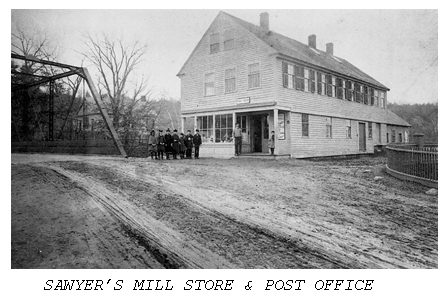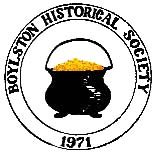Sawyers Mills Village
Sawyers Mills Village
The Early Years
By Inga Milbauer
Before the Wachusett Reservoir was built, there were two distinct sections of Boylston, Massachusetts: ‘Boylston Center’ and the ‘Village of Sawyer’s Mills.’ The village of Sawyers Mills, was located about three miles north of Boylston Center and three miles south of the current dam.
Thomas Sawyer Jr. is often believed to be the first landowner as he acquired the land in the territory that would become Boylston in 1705. Thomas was a son of Thomas Sawyer, one of the first settlers of Lancaster, Massachusetts in 1647. In a raid on the British Colonies, Thomas Sawyer Jr., his son Elias, and John Bigelow of Marlboro were “taken and carried captive to Canada by the Indians in 1705, and for their ransom built a saw-mill (said to be the first saw-mill built in Canada), and then were detained for a time to learn the Canadians how to run their saw-mill.”1 Referring to the Sawyers who settled in America, Amory Carter writes in 1883 that “Every town, village, road and lane throughout New England bears witness of their skill and industry.” He also writes “I have known them as millwrights, wheelwrights, blacksmiths, coppersmiths, carpenters, coopers and, in fact, interested in all the mechanical skill required in New England life.”2 
Thomas Sawyer Jr’s second son, Joseph Sawyer built a dwelling, barn, cornmill and saw mill near the Nashua River in the area that was later called “Sawyer’s Mills.” Joseph, a blacksmith, acquired lands beginning with the 11 May 1721 deed transfer of a portion of the original George Tahanto land, in addition to the land he inherited from his father. Joseph, the son of Thomas Sawyer Jr. and Hannah Sawyer, had been born in Lancaster about 1683. Joseph’s first marriage was to Sarah Rice, the daughter of John Rice, in 1703. They had six children. Sarah died at the age of 37 years, and Joseph married Abigail Beaman on November 10, 1718 at Lancaster.
When Joseph Sawyer acquired the land near the Nashua River it was still part of Lancaster, but the area would later become part of the Town of Boylston. He is considered to be one of the first settlers of Boylston. His son, Aaron, Sr. succeeded him. He built a home not far from the original site of his father’s home. When Aaron Sr. died, his real estate included about 500 acres of land, a dwelling house and barns, an oil mill for the manufacture of neatsfoot oil, a saw and grist mill, and other out-buildings.3 Neatsfoot oil is a yellow oil rendered and purified from the shin bones and feet of cattle. The term neat is old English for cattle. It is used for preserving and softening leather, and in the 18th, century was also used for dry skin conditions.
Aaron Sawyer succeeded his father at Sawyer’s mills. He was a Revolutionary War soldier from Lancaster, and became the first Town Clerk of the Town of Boylston on March 13, 1786. He also served the town as Selectman, Assessor and was a Land Surveyor. At the time of Lieutenant Aaron Sawyer's death on April 30, 1817, t he property at Sawyer’s Mills consisted of a saw mill, a grist mill, a clothier’s mill, and a fulling mill for the manufacture of homespun cloth, an oil mill, a blacksmith shop, a country store, the dwelling house and farm, and farm buildings.4 It is estimated that the store served the residents of Boylston as early as 1787.
he property at Sawyer’s Mills consisted of a saw mill, a grist mill, a clothier’s mill, and a fulling mill for the manufacture of homespun cloth, an oil mill, a blacksmith shop, a country store, the dwelling house and farm, and farm buildings.4 It is estimated that the store served the residents of Boylston as early as 1787.
After the death of Lieutenant Aaron Sawyer, several members of his family managed the property. In 1822, the mills were sold, and James Lees and William Lees, of West Boylston, operated them until about 1830. Sawyer’s mills remained the center of industrial activity. The first United States Post Office in the Boylston area was opened in 1825 at Sawyers Mills. The property at Sawyers Mills was sold to the Clinton Company around 1845 and in 1862 to the Lancaster Mills Corporation owned by the brothers Horatio and Erastus Bigelow. By that time, it had become almost exclusively a textile enterprise.
The Sawyer’s mills complex included not only the mills, machine shops and other buildings related to the textile mill, but also housing for its workers. The Lancaster Mills Corporation built a new store in 1862. The United States Post Office was located in that store. The village was a classic “mill village,” a settlement that develops around one or more mills.
Stay tuned for the upcoming articles with more detailed information about the Sawyer’s Mills’ developing area and its later years!
_________
Acknowledgements:
1Sawyers in America, or A History of the immigrant Sawyers by Amory Carter, Worcester 1883, p. 31
2Sawyers in America, or A History of the immigrant Sawyers by Amory Carter, Worcester 1883, p. 22
3Boylston Historical Series - Vol. III Sawyer’s Mills by Norman H. French, A. Sc., p. 83
4Boylston Historical Series - Vol. III Sawyer’s Mills by Norman H. French, A. Sc., p. 83
Boylston Historical Series by Bruce Filgate, 2012 Vol. I, II, III, XI, XII, XIII
Filgate, Nancy A., editor
https://en.wikipedia.org/wiki/Mill_town; https://en.wikipedia.org/wiki/Neatsfoot_oil
https://www.archive.org/details/sawyersinamerica00cart
https://www.sec.state.ma.us/mhc/mhcpdf/townreports/Cent-Mass/boy.pdf
Photographs from the BHSM archives
Photograph courtesy of Erica Hout, Director, Sawyer Memorial Library
Sawyers in America, or A History of the immigrant Sawyers by Amory Carter, Worcester 1883 – digital version
